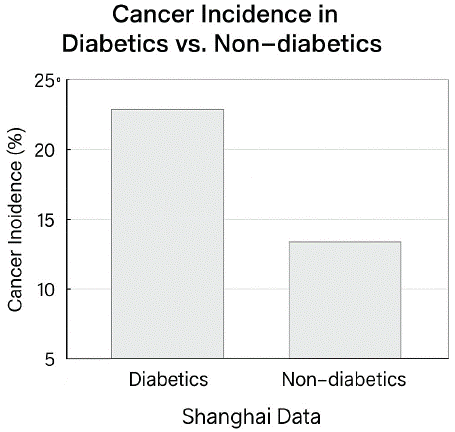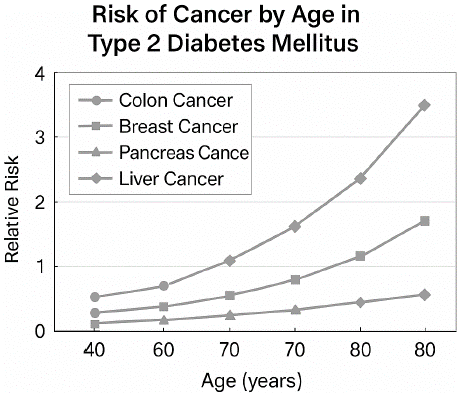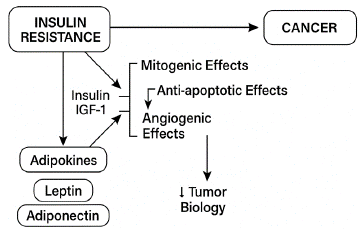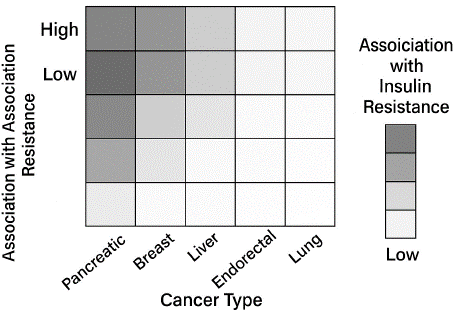
Mini Review
Chronic Dis Int. 2025; 7(1): 1033.
Metabolic Sabotage: The Insulin-Cancer Conspiracy
Muhammed Jasim Abdul Jalal*
Medical Director and Consultant, Department of Internal Medicine and Rheumatology, Olive Health Care, Thrissur, Kerala, India
*Corresponding author: Muhammed Jasim Abdul Jalal, Medical Director and Consultant, Department of Internal Medicine and Rheumatology, Olive Healthcare, Thrissur, Kerala, India Tel: 9544020621; Email: jasimabduljalal@yahoo.com
Received: April 09, 2025 Accepted: April 22, 2025 Published: April 28, 2025
Abstract
Emerging evidence has strengthened the association between Type 2 diabetes and the increased risk of developing several forms of cancer. While obesity and hyperglycemia are well-known contributors, insulin resistance has surfaced as a potential central mechanism underlying this relationship. This editorial dives into the tangled web of hyperinsulinemia, disrupted signaling pathways, and unchecked cell proliferation, uncovering a metabolic conspiracy hiding in plain sight. Targeted interventions to improve insulin sensitivity may offer a promising strategy in reducing cancer incidence globally.
Keywords: Type 2 diabetes mellitus; Cancer; Insulin Resistance
Introduction – Unveiling the Malignant Side of Type 2 Diabetes
Insulin has long been recognized as a key regulator of glucose homeostasis and cellular energy balance. However, growing evidence suggests a more complex role in the context of chronic metabolic dysfunction. Insulin resistance, a hallmark of metabolic syndrome, has been increasingly implicated in cancer development and progression. The global rise in Type 2 diabetes mellitus (T2DM) has drawn attention not only due to its direct metabolic complications but also because of its link to malignancies. An increasing evidence points to a significantly elevated cancer risk among individuals with T2DM, driven by overlapping metabolic, hormonal, and inflammatory pathways. Understanding this relationship is critical in redefining cancer prevention strategies in metabolically vulnerable populations.
Epidemiological Evidence – A Statistical Thriller Unfolds from Shanghai to the UK
Data from the Shanghai Standardized Diabetes Management System, which analyzed over 400,000 individuals between 2011 and 2018, revealed a 10% higher rate of malignancies among people with diabetes compared to non-diabetic counterparts [1]. Data from Shanghai (Figure 1) show a markedly higher cancer incidence among diabetics compared to non-diabetics, suggesting a strong epidemiological link between metabolic dysfunction and cancer development. Furthermore, the risk of developing specific types of cancer, such as colon, breast, pancreas, and liver cancer, increases with age in individuals with T2DM (Figure 2). This age-dependent increase in relative cancer risk underscores the compounding effects of chronic metabolic disturbances over time.

Figure 1: Cancer incidence in diabetics vs. non-diabetics (Shanghai Data).

Figure 2: Risk of cancer by age in Type 2 Diabetes Mellitus.
Notably, cancers of the pancreas, thyroid [2], bladder, kidney, breast, colorectum, and liver demonstrated especially elevated risks, with a more pronounced increase among younger individuals [3].
Studies leveraging the UK Biobank have also identified correlations between insulin resistance and cancer incidence. For instance, the triglyceride-glucose-body mass index (TyG-BMI) product and the triglyceride to HDL-cholesterol (TG/HDL-C) ratio have been employed to evaluate cancer risk, particularly for esophageal adenocarcinoma, which tracked closely with insulin resistance traits [4]. However, esophageal squamous cell carcinoma showed an inverse association with insulin resistance levels, highlighting the heterogeneity of cancer subtypes [4].
The Role of Insulin Resistance - A Tale of Cellular Corruption
Beyond hyperglycemia and obesity, insulin resistance appears to be a unifying factor in the pathophysiology of diabetes-associated cancers. Insulin itself is mitogenic and anti-apoptotic and can promote angiogenesis in a hyperinsulinemic state, which may facilitate oncogenesis [5,6]. These effects are amplified in insulin-resistant states where elevated circulating insulin levels can persistently activate proliferative signaling pathways, notably via the insulin receptor and insulin receptor substrates [7].
In breast cancer, adipose tissue-related factors such as increased leptin and decreased adiponectin further compound these risks [7]. These adipokines, modulated by insulin levels, have mitogenic, angiogenic, and anti-apoptotic properties. Mechanistically, insulin resistance influences malignancy through endocrine (systemic adipokines), paracrine (tumor-associated adipocytes), and autocrine (tumor-secreted factors) pathways [8]. Elevated insulin and insulinlike growth factor-1 (IGF-1) levels have mitogenic, anti-apoptotic, and angiogenic effects that may foster tumor growth and progression (Figure 3).

Figure 3: Mechanistic pathway from insulin resistance to cancer.
Pancreatic cancer development may be facilitated by insulininduced stimulation of pancreatic acinar cells, leading to heightened enzyme secretion and inflammatory responses, potentially promoting metaplasia and neoplasia [8].
Diverse Cancer Associations - A Spectrum of Shadows
Though many malignancies are associated with insulin resistance, this relationship varies across cancer types. For instance, while a strong positive association has been established for hepatocellular carcinoma in high hepatitis B prevalence areas [9], studies on lung cancer have yielded inconsistent findings. Pancreatic and breast cancers demonstrate the strongest links, both in terms of insulin resistance and resistance association (Figure 4).

Figure 4: Association of insulin resistance with different cancer types.
A 9-year follow-up in the UK Biobank showed no significant correlation between lung cancer and the TyG index [10], and a large meta-analysis of over 6.5 million people revealed a correlation between insulin resistance (measured by HOMA-IR) and lung cancer but not with obesity or BMI [11].
Similarly, colorectal cancer incidence has been linked to the TG/ HDL ratio, with data suggesting a protective effect of low TG/HDL rather than a continuous linear risk gradient [12]. These nuanced findings emphasize the need for individualized risk assessment and underscore the complexity of the insulin resistance–cancer connection.
The Metabolic Redemption – Preventive Strategies with Lifestyle Focussing on Insulin Sensitivity
While antidiabetic medications have not consistently demonstrated protective effects against cancer [13], lifestyle interventions show promise. A large-scale study of over 346,000 individuals indicated that self-reported physical activity was associated with a reduced cancer risk [14]. Moreover, an accelerometer-based analysis from the UK Biobank involving 86,556 participants revealed a clear, linear reduction in cancer incidence with increasing physical activity and daily step count [15].
Conclusion – The End is the Beginning: A Call for Metabolic Vigilance
Type 2 diabetes and obesity are strongly associated with elevated malignancy risk, and insulin resistance may be a critical link. With global cancer incidence expected to double over the next five decades [16], public health efforts focused on improving insulin sensitivity through lifestyle interventions may help mitigate this rising burden. Continued investigation is imperative to elucidate the complex molecular and cellular pathways linking insulin resistance to carcinogenesis, thereby informing the development of precise, mechanism-based preventive and therapeutic interventions.
Statement and Declarations
Ethical Statement: The authors are accountable for all aspects of the work (if applied, including full data access, integrity of the data and the accuracy of the data analysis) in ensuring that questions related to the accuracy or integrity of any part of the work are appropriately investigated and resolved.
Author contributions: The author have contributed to the study conception and design.
References
- Zhu B, Song Q, He M, Ju L, Mei F, Tang H, et al. Risk of site-specific cancers in people with diabetes: a nationwide population-based cohort study in China. BMJ Open. 2020; 10: e036852.
- Yeo Y, Ma SH, Hwang Y, Horn-Ross PL, Hsing AW, Lee KE, et al. Diabetes mellitus and risk of thyroid cancer: a meta-analysis. PLoS One. 2014; 9: e98135.
- Lee J, Kim Y, Park SK. Diabetes mellitus and cancer incidence: a Korean nationwide cohort study. Cancer Res Treat. 2021; 53: 789–797.
- Liu X, Wang Y, Wang L, Lu Y, Li X, Qi L, et al. Triglyceride–glucose-body mass index and esophageal cancer risk: findings from UK Biobank. Eur J Clin Nutr. 2023; 77: 120–127.
- Giovannucci E, Harlan DM, Archer MC, Bergenstal RM, Gapstur SM, Habel LA, et al. Diabetes and cancer: a consensus report. Diabetes Care. 2010; 33: 1674–1685.
- Gallagher EJ, LeRoith D. Diabetes, cancer, and metformin: connections of metabolism and cell proliferation. Ann N Y Acad Sci. 2011; 1243: 54–68.
- Gunter MJ, Hoover DR, Yu H, Wassertheil-Smoller S, Rohan TE, Manson JE, et al. Insulin, insulin-like growth factor-I, and risk of breast cancer in postmenopausal women. J Natl Cancer Inst. 2009; 101: 48–60.
- Park J, Morley TS, Kim M, Clegg DJ, Scherer PE. Obesity and cancer— mechanisms underlying tumour progression and recurrence. Nat Rev Endocrinol. 2014; 10: 455–465.
- Wang Y, Liu H, Sun Q, Guo S, Jiang Y, Ren Y, et al. Insulin resistance and hepatocellular carcinoma risk: a prospective cohort study in Northern China. J Hepatol. 2019; 70: 1122–1129.
- Lu Y, Wu Y, Li J, Qi L. Triglyceride-glucose index and lung cancer risk in UK Biobank. Cancer Med. 2023; 12: 2137–2146.
- Zhang X, Zhang Y, Sun G, Ma Y, Ma W. Association of insulin resistance with lung cancer: a meta-analysis of 31 studies. Oncotarget. 2017; 8: 93209– 93219.
- Wu Y, Zhang D, Liu X, Lu Y, Qi L. Lipid ratios and colorectal cancer risk: a prospective cohort study in the UK Biobank. Cancer Epidemiol Biomarkers Prev. 2022; 31: 1307–1315.
- Johnson JA, Carstensen B, Witte D, Bowker SL, Lipscombe L, Renehan AG. Diabetes and cancer (1): evaluating the temporal relationship between type 2 diabetes and cancer incidence. Diabetologia. 2012; 55: 1607–1618.
- Moore SC, Lee I-M, Weiderpass E, Campbell PT, Sampson JN, Kitahara CM, et al. Association of leisure-time physical activity with risk of 26 types of cancer in 1.44 million adults. JAMA Intern Med. 2016; 176: 816–825.
- Saint-Maurice PF, Troiano RP, Bassett DR Jr, Graubard BI, Carlson SA, Shiroma EJ, et al. Association of daily step count and step intensity with mortality among US adults. JAMA. 2020; 323: 1151–1160.
- Sung H, Ferlay J, Siegel RL, Laversanne M, Soerjomataram I, Jemal A, et al. Global cancer statistics 2020: GLOBOCAN estimates of incidence and mortality worldwide for 36 cancers in 185 countries. CA Cancer J Clin. 2021; 71: 209–249.